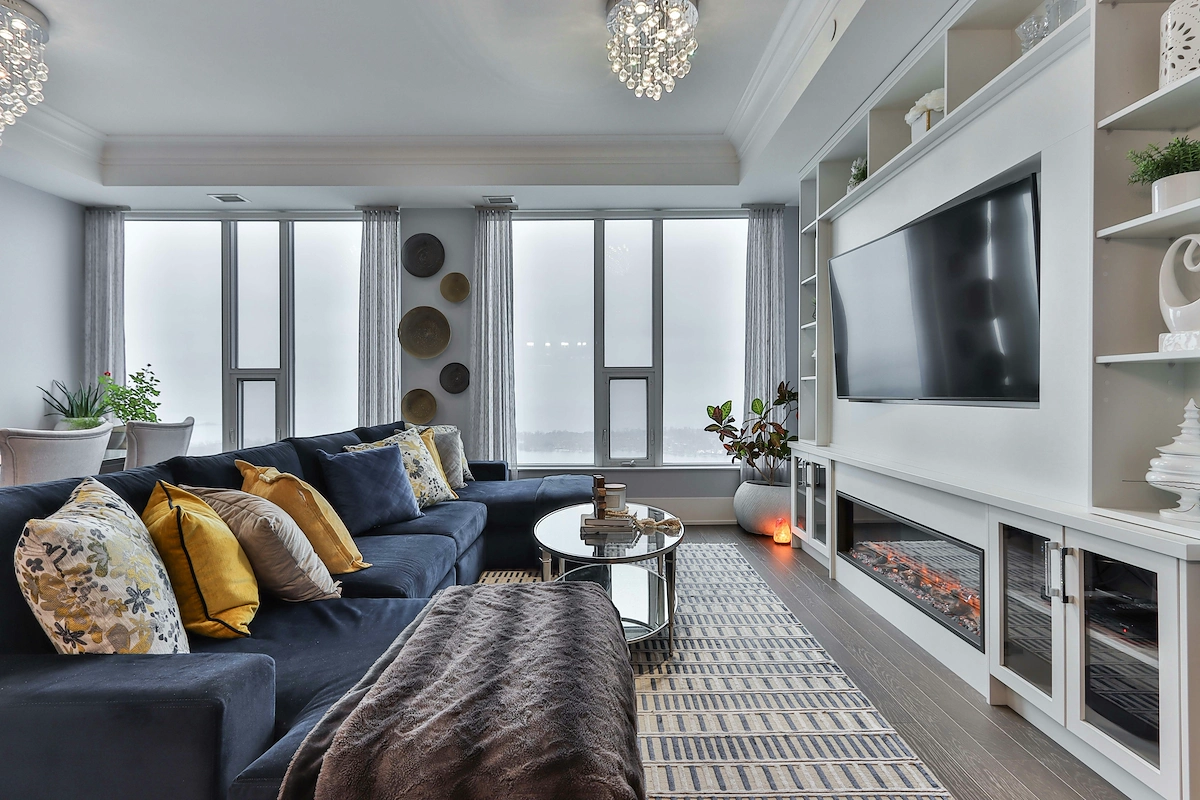Starting a home staging business is a rewarding venture that combines a flair for interior design with smart business sense. The home staging industry is worth billions, with steady demand from homeowners, real estate agents, and property developers.
This guide will take you through the practical steps of validating your business concept, acquiring inventory, obtaining licenses, and building supplier relationships to help you launch a successful staging business in the U.S.
Step 1: Create your business plan and validate the market
Start by talking to the people who will hire you. Contact local real estate agents and property developers to ask what they look for in a stager and what prices they currently pay. You might also attend local Real Estate Staging Association (RESA) chapter meetings to network.
Next, look at your local competition. Search platforms like Instagram and Houzz for stagers in your city. Analyze their portfolios, service packages, and pricing structures. This research helps you find a gap in the market for your unique style or service offerings.
Estimate your startup costs
A common misstep is buying all your inventory at retail prices. To manage your initial investment, you could source from wholesale suppliers or explore furniture rental options first. This approach allows you to build a collection without a massive upfront cash outlay.
Expect to invest between $20,000 and $75,000. This range typically covers a starter inventory ($15,000-$50,000), business insurance ($500-$2,000 annually), and a professional website ($1,000-$5,000). Also, remember to budget for monthly storage, which can run from $150 to $400.
Here are 3 immediate steps to take:
- Interview at least three local real estate agents about their needs.
- Analyze five local competitors to identify their style and pricing.
- Draft a startup budget with estimated costs for inventory and insurance.
Step 2: Set up your legal structure and get licensed
You should consider forming a Limited Liability Company (LLC). This structure protects your personal assets, like your home and car, from business debts or lawsuits. For tax purposes, an LLC is simpler than a corporation because profits pass directly to your personal tax return.
Once you decide on a structure, get a free Employer Identification Number (EIN) from the IRS website. Think of it as a Social Security number for your business. You will need it to open a business bank account and file taxes. The online application takes about 15 minutes.
State and local requirements
Next, visit your state's Secretary of State website to officially register your LLC, which can cost between $50 and $500. You will also need a state seller's permit or resale certificate. This permit allows you to purchase inventory wholesale without paying sales tax.
Many new stagers miss getting that resale certificate and end up overpaying for inventory. Also, check your city or county clerk's office for a general business operating license. These typically cost $50 to $150 annually and ensure you comply with local rules.
While there is no mandatory government body for staging, joining an organization like the Real Estate Staging Association (RESA) adds credibility. It shows clients you adhere to a professional code of ethics and stay current with industry standards.
Here are 3 immediate steps to take:
- File for an LLC with your state's Secretary of State.
- Apply for a free Employer Identification Number (EIN) on the IRS website.
- Research your state's seller's permit and your city's business license requirements.
Step 3: Secure your insurance and manage risk
Insurance protects your business from accidents that can happen during a staging project. It also shows clients and real estate agents that you operate professionally. Many partners will not work with you unless you can show proof of adequate coverage.
Key insurance policies to consider
General liability insurance covers property damage or injuries to third parties. For example, if your team scratches a hardwood floor or a client trips over a rug. A $1 million policy typically costs between $400 and $1,500 annually.
You should also get professional liability insurance. This policy protects you if a client claims your design advice led to a financial loss, like a home not selling. It covers errors and omissions specific to your service.
In addition, commercial property insurance protects your inventory from theft or damage while in storage or at a client's home. If you use a vehicle to transport furniture, you will need a commercial auto policy, as personal auto insurance will not cover business use.
Here are 3 immediate steps to take:
- Request quotes for a $1 million general liability policy from providers like Hiscox or The Hartford.
- Ask an insurance agent about adding professional liability coverage to your plan.
- Check your state's requirements for workers' compensation if you plan to hire help.
Step 4: Find your space and build your inventory
Secure your storage and start buying
You need a place for your inventory. Look for a climate-controlled storage unit between 500 and 1,000 square feet, which holds enough furniture for two to three homes. Check that the facility has commercial zoning and allows frequent truck access for deliveries and pickups.
When you talk to landlords, ask for 24/7 access. A staging job can require you to pull items outside standard business hours. A mistake some new stagers make is getting stuck with 9-to-5 access, which disrupts project timelines. A month-to-month lease offers flexibility as you grow.
Now, build your core inventory with versatile, neutral pieces. A starter list includes a light-colored sofa ($800-$2,000 wholesale), two accent chairs ($200-$500 each), and a dining set ($500-$1,500). Also add queen-sized beds, large neutral rugs, and varied artwork.
You can find suppliers at trade shows like High Point Market or through online wholesale directories. Many have minimum order quantities (MOQs), so you may need to purchase $1,000 to $5,000 at a time. Steer clear of overly trendy items that will quickly look dated.
Here are 3 immediate steps to take:
- Tour three local storage facilities to compare access hours and lease terms.
- Create a starter inventory list with a budget for foundational furniture.
- Identify two wholesale furniture suppliers and ask about their minimum order requirements.
Step 5: Set up your payment system
Establish clear payment terms from the start. A standard practice is to require a 50% non-refundable deposit to book your services and reserve inventory. The remaining balance is then due upon completion of the staging or before de-staging begins.
Choose your payment solution
You need a reliable way to accept payments. Many solutions charge average commission rates of 2.5% to 3.5% plus monthly fees, which can quickly reduce your profit margins. Look for a system with transparent, low transaction fees and no long-term contracts.
For staging businesses that need to accept payments on-site, JIM offers a streamlined solution. With JIM, you can accept debit, credit, and digital wallets directly through your smartphone. Just tap and done. At just 1.99% per transaction with no hidden costs or extra hardware needed, it is particularly useful for collecting final payments from clients at their property.
Getting started is simple:
- Get Started: Download the JIM app for iOS.
- Make a Sale: Type the sales amount, hit sell, and ask your customer to tap their card or device on your phone.
- Access Funds: Your money is available right on your JIM card as soon as the sale is done, with no waiting for bank transfers.
Here are 3 immediate steps to take:
- Draft a standard contract that outlines your 50% deposit policy.
- Compare transaction fees from at least two different payment solutions.
- Download the JIM app to see how it works for on-the-go payments.
Step 6: Fund your business and manage finances
A business line of credit is a flexible option for inventory purchases. Unlike a fixed loan, it lets you draw funds as needed. Banks often look for a personal credit score above 680 and a solid business plan to approve an application.
For a larger, one-time investment, consider an SBA Microloan. These government-backed loans go up to $50,000 and are designed for startups. Interest rates typically range from 8% to 13%. You can find a local lender through the SBA's website.
Estimate your working capital
You will need a cash reserve for your first six months. Budget between $10,000 and $20,000 for working capital. This covers costs like storage, insurance, and marketing before client payments create a steady cash flow. A common misstep is underestimating these early expenses.
While staging-specific grants are rare, you can apply for general small business grants, such as the Amber Grant for women entrepreneurs. However, grants are highly competitive, so you should not depend on them as your primary funding source.
Here are 3 immediate steps to take:
- Contact your bank to ask about qualifications for a business line of credit.
- Research local SBA Microloan lenders through the SBA's official website.
- Calculate your estimated working capital needed for the first six months.
Step 7: Hire your team and set up operations
Once you consistently juggle two or more projects a month, it is time to hire help. Start with a part-time Staging Assistant. This role handles the heavy lifting, packing, and setup. Expect to pay between $18 and $25 per hour for reliable help.
A word of caution: many new stagers hire friends or family to save money. This can strain relationships if expectations are not clear. Always use a formal contract that outlines pay and responsibilities, no matter who you hire.
Streamline your workflow
As your inventory grows, you need a system to track it. Project management software designed for stagers, like Stageforce or Stager-Ware, helps you manage inventory, schedule jobs, and create proposals. This prevents double-booking a sofa or forgetting a key piece of art.
As a general guide, consider hiring a full-time employee for every $150,000 in annual revenue. This ratio helps you scale your operations without sacrificing the quality of your work. Your first full-time hire might be a Lead Stager who can manage projects independently.
Here are 3 immediate steps to take:
- Draft a job description for a part-time Staging Assistant with clear responsibilities.
- Request a demo from an inventory management software like Stageforce.
- Outline the specific tasks you would delegate to your first hire.
Step 8: Market your business and attract clients
Your portfolio is your most powerful marketing asset. After your first project, hire a professional real estate photographer. It can cost between $300 and $600, but high-quality images are non-negotiable. Many new stagers try to save money with phone pictures, which often backfires with potential clients.
Build your online presence
Create a simple website to showcase your portfolio and services. Platforms like Squarespace or Wix are user-friendly. Also, set up business profiles on Instagram and Houzz. Post before-and-after photos and client testimonials consistently, perhaps three to four times a week, to build credibility.
Network with your target audience
Focus your efforts on building relationships with local real estate agents. They are your primary source of repeat business. Identify ten high-producing agents in your area and send them a personalized email introducing your services. You might offer a 10% discount on their first project.
Your goal is to become the preferred stager for a small group of agents. This provides a more reliable stream of projects than broad, unfocused marketing. Once you have a few successful projects, ask agents for testimonials to feature on your website.
Here are 3 immediate steps to take:
- Hire a professional photographer for your first completed project.
- Set up a business profile on Instagram and Houzz and post your first project.
- Identify ten local real estate agents to contact with an introductory offer.
Step 9: Price your services and define your packages
Choose your pricing model
Most stagers use a price-per-room or a flat-fee package model. For example, you might charge $700-$1,200 for a living room and $500-$900 for a primary bedroom. This fee typically covers the first 30-60 days of staging.
You can also offer a consultation-only service for $250 to $600. This involves a two-hour walkthrough where you give the homeowner a detailed staging report. It is a great entry-level service to build your portfolio and client base.
Remember to include a monthly furniture rental fee in your contract. This is usually 25-35% of the initial staging fee for each additional 30-day period. A mistake many new stagers make is forgetting this clause, which eats into profits on homes that sit on the market.
Set your profit margin
Aim for a net profit margin of 40% to 60% on each project. To calculate this, subtract all your direct costs—like movers, inventory amortization, and insurance—from your total fee. Your pricing must cover both your time and the use of your assets.
To see what the market will bear, research your competitors. Call a few local stagers and ask for a quote on a hypothetical 2,000-square-foot home. This gives you direct insight into their pricing and package structures.
Here are 3 immediate steps to take:
- Decide on a primary pricing model, such as a per-room or flat-fee structure.
- Call three local competitors to get quotes for a sample 3-bedroom house.
- Create two service packages, like a "Key Room" package and a "Full Home" package, with clear prices.
Step 10: Maintain quality and scale your operations
Establish your quality standards
As you grow, consistent quality builds your reputation. You can adopt the Real Estate Staging Association (RESA) Code of Ethics as your baseline. Create a final walkthrough checklist for every project to ensure nothing is missed, from fluffing pillows to cleaning fingerprints off glass.
To measure success, track the percentage of your staged properties that go under contract within 30 days. You might also send a simple post-project survey to agents asking them to rate your service on a scale of 1 to 5. This gives you direct feedback.
Know when to grow
Growth should be strategic, not reactive. A good benchmark is to consider a full-time hire for every $150,000 in annual revenue. When you start turning down more than two projects a month because of inventory shortages, it is time to increase your wholesale purchasing budget.
Software like Stageforce or Stager-Ware becomes more valuable as you scale. Use their features to forecast inventory needs and manage multiple project timelines at once. This prevents logistical headaches and keeps your operations smooth.
Here are 3 immediate steps to take:
- Create a final walkthrough checklist based on RESA's Code of Ethics.
- Set a revenue goal, like $150,000, as the trigger for your first full-time hire.
- Analyze the inventory forecasting features in software like Stageforce.
Starting your staging business is about design and smart operations. Remember that your relationships with real estate agents are your most valuable asset. You have the steps, now go build your business one room at a time.
And to keep your finances simple, JIM turns your smartphone into a card reader. You can accept payments anywhere for a flat 1.99% fee, with no extra hardware. Download JIM to get started.















